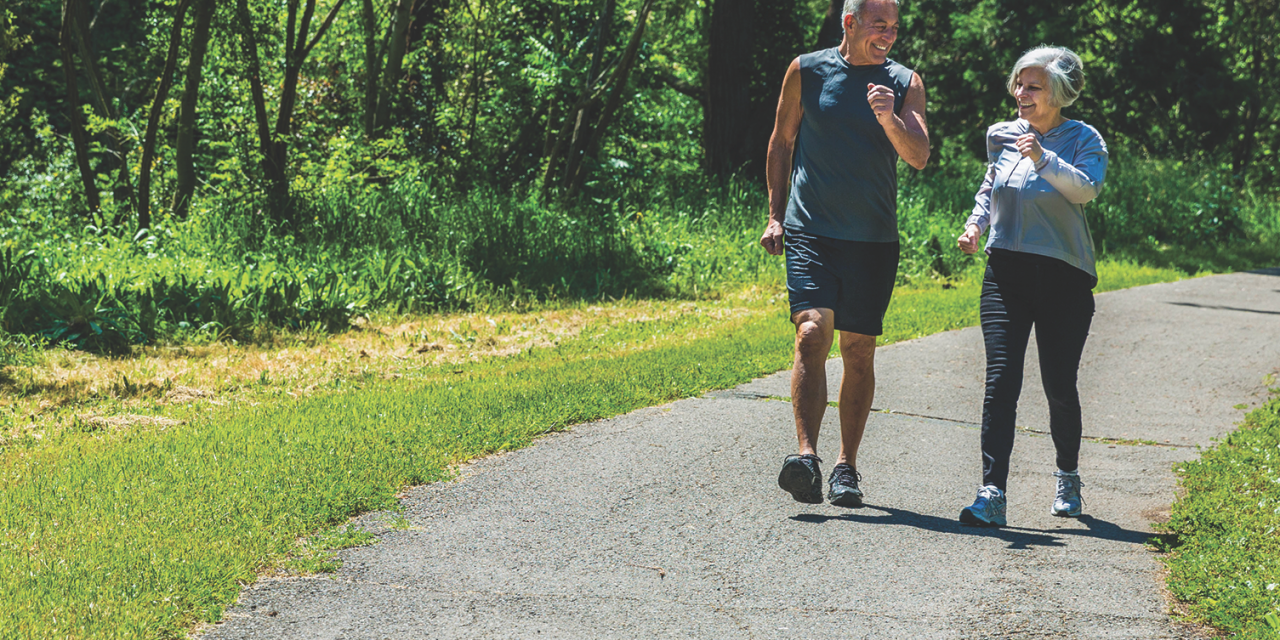By J. Ron Eaker, M.D.
As the weather improves so should your desire to get outside and get moving. If I had a pill that would make you look better, feel better, reduce your incidence of breast cancer or prostate cancer, didn’t cost anything and had no side effects, then most of you would beat a path to the pharmacy to get one. That pill does exist. It’s called exercise and it takes about 30 minutes to swallow!
Exercise is truly the fountain of youth. There is no single activity that you can do that will have a more profound impact on your health than a 30 minute sweat session. The benefits of exercise are legion and I won’t bore you with the rationale for getting active. Okay, maybe I will bore you but only because it bares repeating. You all know that exercise is essential for weight management, cardiovascular health, improved circulation, better lung function and a more youthful appearance, but did you know it can also be a treatment for depression, reduce the pain of menstrual periods, decrease the incidence of gallstones and boost brain function?
When you exercise, your body releases chemicals called endorphins. Endorphins are neurotransmitter hormones (somewhat like serotonin) that are secreted from the pituitary gland as a result of vigorous exercise. Endorphins, like other neurohormones, can trigger a positive feeling in the body, similar to that of morphine. A Harvard review of studies stretching back to 1981 concluded that regular exercise can improve mood in people with mild to moderate depression. Regular exercise also may play a supporting role in treating severe depression. Another study showed that the benefits of exercise lasted longer than the effect of an antidepressant. In other words, those who suffered from depression felt better six months after initiating a regular exercise program, whereas fewer on antidepressants felt better in that same time frame. There is also evidence that regular exercise can reduce chronic anxiety issues as well as some compulsive behaviors. Most of the studies vary as far as how much and how vigorous the exercise needs to be to exert a positive mood benefit, yet they all agree that even a small amount of regular exercise can be helpful.
As a practicing gynecologist, I see women struggling with painful, often debilitating menstrual cycles. There are a variety of mechanisms I employ to thwart these miserable occurrences but virtually all treatments have side effects… except exercise. Numerous studies have proven that exercise before and during the cycle can reduce not only the pain associated with menses but even the heaviness of the flow. It all goes back to our friends the endorphins becaue they act centrally to block the pain receptors and reduce the production of prostaglandins, other hormones that can influence pain. In fact, some studies indicate that naturally produced and released endorphins can have as powerful a pain reducing ability as morphine. Many women complain that vigorous exercise (either before or during their period) is either difficult or undesirable. However, several studies suggest that only 30 minutes of moderate aerobic exercise is needed to get a pain reducing effect.
Women have a greater chance of reducing the likelihood of surgery for gallstones if they are regular exercisers. One particular mechanism is related to weight. Being overweight is a known risk factor for gallstones so it follows that regular exercisers are less likely to have a weight issue, thus reducing their risks for gallbladder disease. In 1999, a study in The New England Journal of Medicine concluded, “Women who exercised the most were 31% less likely to have gallstone surgery than the least active women.” Even a moderate amount of exercise was linked to a significant decline in the risk of gallbladder surgery. Two to three hours of recreational exercise per week appeared to reduce the risk of surgery by approximately 20%. Sedentary women who spent less than six hours per week sitting at work, driving and women who spent 41 to 60 hours a week sitting were 42% more likely to undergo gallbladder surgery. Several mechanisms for this benefit were proposed including increased gut motility and decreased blood triglycerides in exercisers as compared to sedentary folks.
Dr. John Ratey, in his ground breaking book Spark: The Revolutionary New Science of Exercise and the Brain, states that, “Exercise also stimulates brain regions that are involved in memory function to release a chemical called brain-derived neurotrophic factor (BDNF). BDNF rewires memory circuits so they work better…When you exercise and move around, you are using more brain cells.”
The take home message is clear: It’s good to move so dust off those bikes, lace up the Nikes, find the swim goggles or simply get out the walking socks. Your gallbladder will appreciate it!
This article appears in the May/June 2017 issue of Augusta Family Magazine.
Did you like what you read here?








